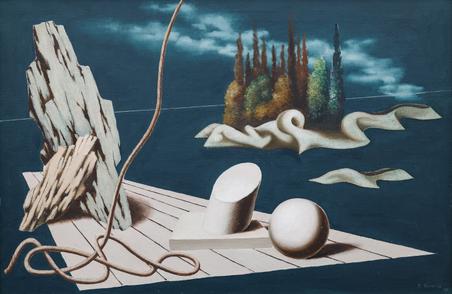Lot #42

František Muzika (1900–1974)
Island III
Estimate: 7,000,000 CZK - 14,000,000 CZK
6,500,000 CZK
This prime work by Muzika stands out for its exceptional painterly sophistication and can be ranked among the most significant of the author’s pieces thanks to its qualities of form and content. František Muzika is among the first Czech artists to register the changes to the European cultural atmosphere brought about by Surrealism in the early 1930s. The swift expansion of the Group of Surrealists in Czechoslovakia, founded in 1934, recalls the early phase of the avant-garde art association Devětsil in its intensity, scale, and degree of interest in new, collective thought. Muzika never became a member, however, even though his work has many traits in common with the movement. His character, where a romantic disposition and sense of order predominated, did not allow him to identify fully with a movement founded purely on the subconscious. Nevertheless, Surrealism opened up new horizons and possibilities for him to fully develop imaginative painting, of which he had become the leading Czech representative. In it, he found the most fitting approach to experiencing the work with uncommon sensitivity. The poetry of Muzika’s imaginative works was influenced in part by the early Italian metaphysical works of Giorgio de Chirico and partly by his own experience as a set designer. His canvases often depict imaginary stages, where the actors are women’s torsos or enigmatic objects entering into unusual associations where they take on new symbolic meanings. With the approach of the 1940s and the onset of war, Muzika began to appear more frequently in public as a stage designer or book graphic designer rather than as a painter or pedagogue, even though his work did not escape the socially engaged themes, tragic allegories, and, eventually, the spectres of war demanded by the period. In the latter half of the 1930s, Muzika developed two primary themes – reclined figures in landscapes and the Islands cycle. The listed Island III (Island I, 1934; Island II, 1936) is situated in a metaphysical landscape, where disparate objects encounter one another in an imaginary space that suggests a theatrical stage. In the atmosphere of a dramatic scene, inanimate objects become actors – a ball, the fragment of a column, rough-hewn boulders, tree bark, and a suspended coiled rope. This impression disrupts the background of the painting, where the silhouette of an island floating on undulating drapery emerges. At that moment, the entire scene transforms, suggesting instead a raft on a calm surface of water. The observer is thus drawn into a dream world of individual motifs, the hidden meaning of which can be revealed through a subsequent interpretation that fully engages their intellect. The work contains no immediate urgency and has no need to assault or absorb the viewer; on the contrary, it evokes a magical space for dreaming and captures the artist’s sense of life and the depth of his personal experiences. The work has been repeatedly exhibited and published. It was included in the presentation of the Rudolf Hršel Collection – Modern Czech Art from the Collection of Rudolf Hršel (Regional Gallery in Hradec Králové, June 1967, cat. no. 19) and Czech Modern Art from the Collection of Rudolf Hršel (Art Gallery Karlovy Vary, 16 March – 20 April 1969). It was exhibited at the artist’s retrospective, František Muzika: Paintings from 1920-1964 (Regional Gallery in Hradec Králové, 7 June – 5 July 1965, cat. no. 46) and at an essential retrospective organised by Jiří Kotalík (František Muzika: Paintings, Drawings, Set Designs, Book Graphic Design, Waldstein Riding School, National Gallery in Prague, September – October 1981, cat. no. 59). It was reproduced in a monograph by František Šmejkal (František Muzika, Prague, 1966, fig. 59) and the book České imaginativní umění (Czech Imaginative Art, F. Šmejkal, Prague 1996, fig. p. 201). The work is number 416 in Muzika’s catalogue; the number is inscribed on the verso of the canvas. Originally part of a significant East Bohemian collection. Assessed in consultation with Prof. J. Zemina and PhDr. R. Michalová, PhD. The expert opinion of PhDr. K. Srp is attached: “[...] We have before us one of František Muzika’s most complex paintings, his culminating work of the latter half of the 1930s, which is powerful in its significance, its sophistication, its numerous references to the diverse visual art sources and artistic interpretation. This is metaphysical painting par excellence. [...].”




